SMS settings
SMS gateways are used to send SMS/OTPs and alerts. There are two options for sending SMS messages:
-
Default: With this option, SMS messages are sent via your service provider’s SMS gateway. You can use this option only if your service provider has allocated SMS credits to your virtual server.
To verify your SMS credits allocation, on the STA Token Management console, select Snapshot > Allocation and check the SMS Credits column.
-
Custom: Select this option to configure the virtual server to send SMS messages via a gateway service to which you’ve subscribed or an SMS modem that is installed at your site.
To verify the ability to send SMS messages, in the SMS Mobile Number field, enter the number of a device that is capable of receiving SMS messages. SMS phone numbers must consist of only digits and must begin with a country code.
Use an SMS gateway service or modem
To configure the virtual server to use an SMS gateway service or modem:
-
On the STA Token Management console, select Comms > Communications > SMS Settings.
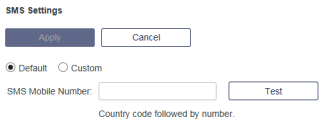
-
Select the Custom option.
-
Select the Custom option.
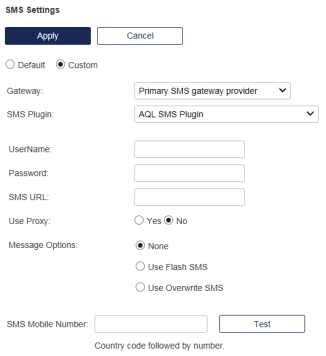
-
Provide the details about the SMS provider that you are using:
-
Gateway: Select to configure a primary and failover SMS service provider.
-
SMS Plugin: The list includes a number of preconfigured providers, including the SMPP SMS plugin. If the SMS provider you are using is not listed, select the Generic HTTP(s) SMS Plugin option.
Each preconfigured SMS provider has different configuration options. Your gateway service provider can supply the necessary configuration information.
For the Clickatell SMS plugin, if you purchased the customization feature from Clickatell, you can use an alternative Sender ID. When you select Clickatell SMS Plugin, a message next to the Sender ID field indicates the requirements for this optional functionality.
-
-
Configure the other options, depending on your network and SMS gateway service provider:
-
Use Proxy: If you send SMS messages via a proxy server, select Yes, and then add the Proxy URL, Proxy Port, Proxy Username, and Proxy Password.
-
Use Flash SMS: Use this option if the gateway supports Flash SMS and you do not want SMS messages stored on the receiving device.
-
Use Flash SMS: Use this option if the gateway supports Flash SMS and you do not want SMS messages stored on the receiving device.
-
Use Overwrite SMS: Use this option if the gateway supports overwrite SMS, which causes each new message to overwrite the previous SMS message stored on the receiving device.
-
-
Select Apply.
- Select Apply.
Configure a generic HTTP(S) SMS plugin
When there is a requirement to add a query parameter, such as an access token, as the first query parameter, you can append that query parameter to the base URL. You can add additional query parameters to the pre-defined destination and message parameters and these additional query parameters get appended to the end of the URL after all the preceding query parameters.
-
To configure communication with SMS service providers that are not included in the SMS Plugin list, select the Generic HTTP(s) SMS Plugin option.
Refer to the provider’s documentation for guidance on formatting entries in STA.
-
Configure the following options, as required:
-
Method Name: Select GET or POST, based on what your SMS service provider requires.
-
Add parameters to URL: When set to True, this function encodes a space as a plus + sign, as specified in URLEncode(). If set to False, a space is encoded as %20. Check with your SMS provider as to which setting is recommended. Most SMS providers support both encodings, while some support only one of the two available options.
-
SMS URL: Enter the SMS URL. For example: http://api.<SMS provider>.com/http/sendmsg
The base URL can include only one query parameter (or none). Including more than one query parameter causes an error.
-
If you select the GET method, the SMS message is sent as a page request with the parameters on the same line as the URL. They are appended to the page name with a ?, followed by the key, followed by an =, and then the value. Use & to add another key-value pair.
-
If you select the POST method, the SMS message is sent as a page request with the parameters attached as a query string included in the message body (rather than with the URL).
-
-
Destination Parameter Name: Enter the name (a key, as described above in SMS URL) that the SMS provider wants for the mobile phone number.
-
Message Parameter Name: Enter the name (a key, as described above in SMS URL) that the SMS provider wants for the message to be sent.
-
Success Message Contains String: Enter the text string that STA sends back for a success message.
-
Use Proxy: If you send SMS messages via a proxy server, select Yes, and then add the Proxy URL, Proxy Port, Proxy Username, and Proxy Password.
-
-
If additional parameters are required, click Add Parameter, and enter them as key-value pairs.
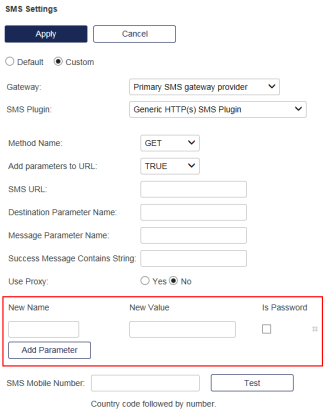
-
To hide the contents of a field, select Is Password.
-
Select Apply.
Configure a generic OAuth SMS plugin
You can use the OAuth protocol to send enrollment token messages and OTPs through SMS via REST APIs. Refer to the service provider’s documentation for their configuration values.
To configure SMS service providers that use the OAuth protocol:
-
Select Generic OAuth SMS Plugin.
-
Configure the following options, as required:
-
Client ID: Enter the client ID that the SMS provider requires for the token API.
-
Client Secret: Enter the client secret that the SMS provider requires for the token API.
-
Grant Type: Enter the grant type that the SMS provider requires for the token API.
-
Token URL: Enter the token API URL that the SMS provider requires for the SMS API.
-
SMS URL: Enter the SMS URL that the SMS provider requires for sending SMS.
-
Sender Name: Enter the Sender Name that the SMS provider requires for sending SMS.
-
Use Proxy: If you will be sending SMS messages via a proxy server, select Yes, and then add the Proxy URL, Proxy Port, Proxy Username, and Proxy Password.
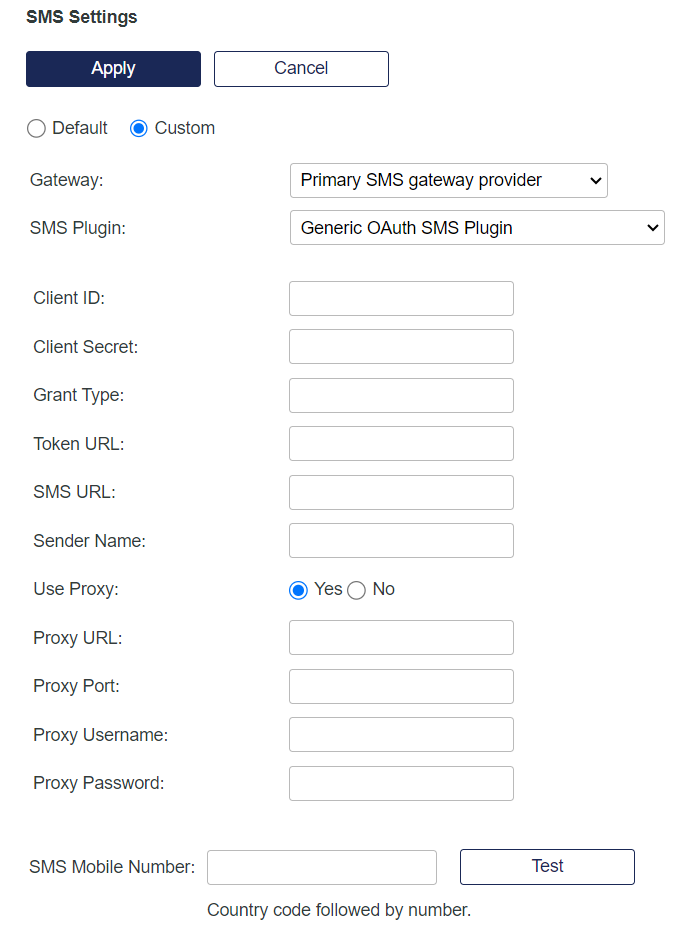
-
-
Select Apply.
SMPP SMS plugin
When selected, the Short Message Peer-to-Peer (SMPP) setting allows for the transfer of information to and from the user through short messages.
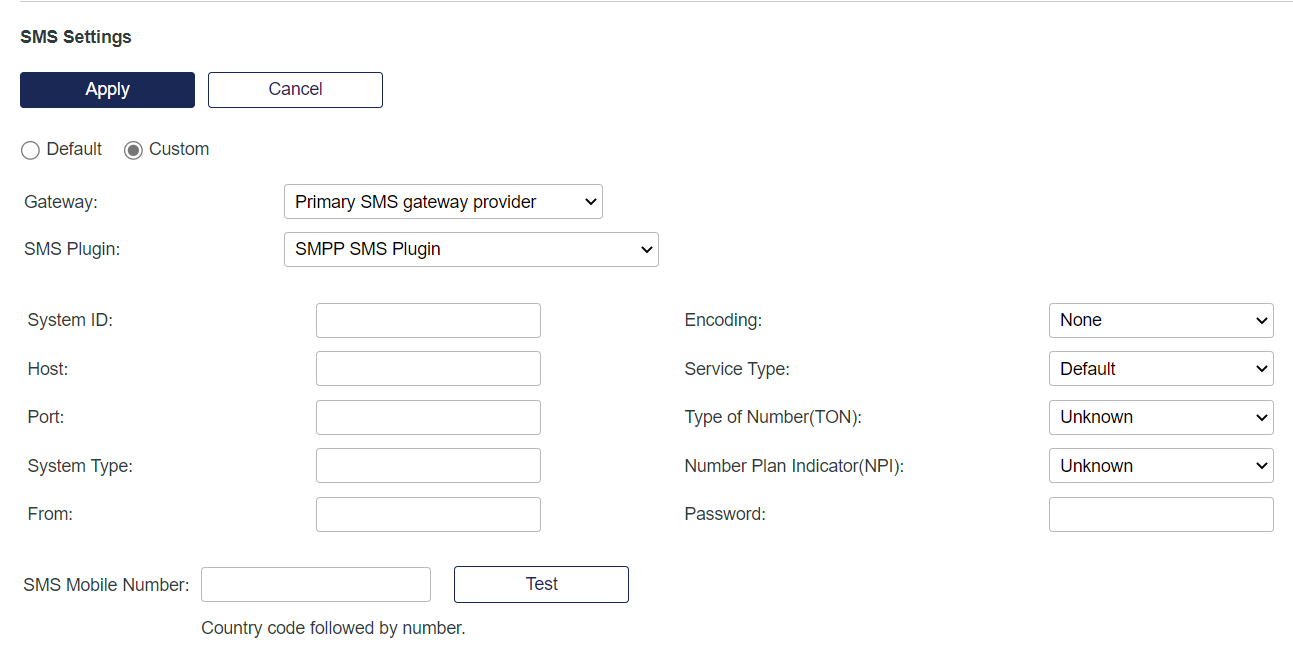
Configure the SMPP SMS plugin options as required:
-
System ID: Enter the system ID of the ESME (External Short Messaging Entity) that needs to connect to the SMSC (Short Message Sevice Center) server.
-
Host: Enter the address of SMPP Server (SMSC).
-
Port: Enter the port of SMPP Server (SMSC).
-
System Type: (Optional) This parameter is used to categorize the type of ESME that is connecting to the SMSC server. If the SMSC doesn't require this setting, set it to NULL.
- Success Message Contains String: Enter the text string STA sends back for a success message.
-
Encoding: To specify the type of encoding that is used in the message, select from the following options:
- utf16be
- ucs2
- smcdefaut (default)
- asci
- latin1
-
Service Type: To specify the SMS application service that is associated with the message, select from the following options:
- Default
- Cellular Messaging
- Cellular Paging
- Voice Mail Notification
- Voice Mail Alerting
- “Wireless Application Protocol
- Unstructured Supplementary Services Data
- Other
-
Type of Number (TON): To indicate the type of number that is being used for messaging, select from the following options:
- Unknown
- International
- National
- NetworkSpecific
- SubscriberNumber
- Alphanumeric
- Abbreviated
-
Number Plan Indicator (NPI): To define the numbering plan that is associated with your messaging service, select from the following options:
- Unknown
- ISDN
- Data
- Telex
- LandMobile
- National
- Private
- ERMES
- Internet
- WapClient
-
Password: To authenticate the identity of the connecting ESME, enter the password for the SMSC.

